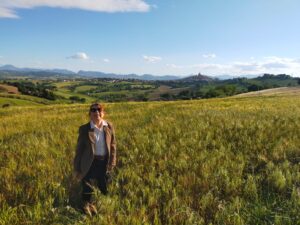Archaeological treasures in the Ligurian Riviera, near La Spezia
Aquileia before the Roman Age
Imagine to take a trip in the 1st Century b.C.
Imagine to take a touristic trip of Aquileia during the 1st century b.C., when the town was founded as a military community by the Romans. You would arrive at the main avenue of the city, where there would be a lot of statues and marble busts representing funeral monuments to the most important people in the city. Something curious: most of those statues represent the relatives saying goodbye to the deceased by making the sign of the horns. Here is where this propitiatory gesture comes from!
Keep on going, you would have the chance to admire a very flourishing city, the nodal point that people used to head for when leaving from Alessandria and the Middle East to the North of Europe, and back.
Otherwise, if you were traveling in 313 a.C., you would have the chance to visit the great Christian Basilica: the bishop Teodoro had it built after Christianity prevailed over Mithraism.
What about Mithraism?
Mithraism was an ancient religion from Persia, very popular among the Romans, especially the soldiers. Some experts define Mithraism very similar to the Christian religion: Mithra was a saviour God, the followers had faith in a Last Judgment, in a resurrection, in a final battle between Good and Evil at the end of time, and in some kind of reward (just like Paradise). Both the two religions thought to Baptism as a purification, the only way to become part of the community.
The birth of Mithra was thought to be on the 21st of December, the day of the winter solstice, more or less the same period of Christian Christmas. The legend says that Mithra was born in a cave and there were some shepherds and Wise Men (typical expression that indicates sages coming from Asia) to pay homage. Last but not least, the legend says that he was born from a virgin woman too.
The representation of Mithra was hidden in a cave, just like many other divinities of fecundity by that time. It was taken away every year during Spring time to make the God come back to life.
In the Roman society only men could dedicate rituals to Mithra, especially from the high military caste. At the Archaeological Museum of Aquileia I learnt that this strict selection made Christianity prevail over Mithraism, because both women and poor people preferred Christ to Mithra.
In the end, Emperor Constantine decided to embrace the Christian religion and he defeated those who were instead devoted to Mithra. By that time, a real hunt against people devoted-to-Mithra bagun and all the sanctuaries consecrated to Mithraism were completely destroyed. Nowadays it is difficult to find any ruins, their places of worship were just caves to celebrate baptisms with the blood of a bull instead of water. This difference explains why, in the end, a more peaceful religion as Christianity replaced a more pagan and aggressive one as Mithraism was.
However, that’s why the last Cave consecrated to Mithraism is very important, surrounded by the hills in the area of Monfalcone. There is a breach on the top of the cave, from where the blood flowed to wet the initiate to the community. At the core of the cave there is a sort of altar, where the bread used to be broken during the rites. Experts found also a lot of coins and offerings. It is not so easy to reach the cave: it is in the area of Timavo river, near the small city Duino. Near the underpass of the highway there is a path… Ask, you will be guided to.
Finally, if you were in Aquileia before the Roman age you would see a great pile-dwelling village, similar to the Italian Terramare dwelling villages. It was much more close to the see than it is today. It has always been a trade area and a crossing point for people coming from and going to every part of the world. This place still has this economical and cultural privilege!
Main pic courtesy of Flickr User “Ho visto Nina volare”
Visit Trieste: helpful hints
Arrivals
Trieste has a national and international airport, but for transcontinental flights you have to stop in other airports. Otherwise you can arrive in Trieste by trains, buses or cars. At the airport you can get a local train to the city centre (30 minutes ride, 4€), same by bus.
Transports
Trieste is a small city, you can visit it walking or you can choose the public transports. The single tickets costs 1,25€ and it lasts 60 minutes. Something you should probably do is taking the typical Opicina’s tramway, a centenary tiny train running from Oberdan square to Opicina villa. Currently the service is not available, but hopefully it will reopen soon, check it.
What to do
Trieste is the capital city of Friuli Venezia-Giulia region, North Eastern Italy, towards Slovenja. The historical centre is really beautiful, don’t miss Piazza dell’Unità (i.e. the main square, on the dock) and San Giusto’s castle. Miramare Castle deserves a visit too, located a bit farther from the very centre, you can see it perched on the gulf from the main dock.
Nearby, the Roman village of Aquileia is listed between the UNESCO Heritage Sites and if you are fond of active tourism and nature, explore the Natural Reserve Cona Island. Check #italiaslowtour deals page to get a tour in the natural environment near Trieste on a budget.
Every October in the Gulf of Trieste takes place the Barcolana, the largest regatta in the world. Hundreds of sailing boats different in shape and size compete in a non professional race. Such a unique sport event!
Where to sleep
Accomodation in Trieste can be quite expensive, better to book in advance!














